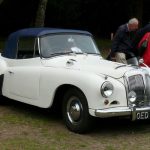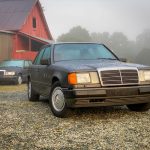Many people think that De Tomaso was a one-hit wonder, and that the only car the company produced was the Pantera. But not only was there the Vallelunga, which we’ve covered here, there was also the Deauville and the Longchamps. We’ll save the latter for another day, because this week’s oddball classic is a four-door saloon that looked suspiciously like a Jaguar XJ40 – a car which made its debut just as the Deauville’s 15-year production run was coming to an end.
When laying out its case for the Deauville, De Tomaso’s aim was to deliver the world’s most opulent saloon, and draw clients away from the luxury big-hitters such as the Jensen Interceptor, Lamborghini Espada, Aston Martin DBS V8 and the Ferrari 365 GTC/4. The Deauville was unique in this company in having a quartet of doors, so that those in the back seats could get in and out more easily. It’s a formula that Monteverdi would follow with its 375 saloon.

The man behind the Deauville was Lee Iacocca, the charismatic Ford boss who had started to work with Alejandro De Tomaso on the Pantera project. During a visit to the design studios, Iacocca got chatting to stylist Tom Tjaarda, making it clear that he was a great fan of the Jaguar XJ. When he next visited, this time with Henry Ford II, the die was cast for De Tomaso to build its own luxury four-door saloon, which Tjaarda also designed.

Appearing just a few months after the Pantera, the De Tomaso Deauville burst onto the scene in 1970 at the Turin Salon. Both cars used the same Ford-sourced ‘Cleveland’ push-rod cast-iron 5763cc V8, which in the Deauville was rated at 275bhp, but whereas the Pantera’s powerplant was mounted in the middle, the Deauville’s was in the nose. A Ford three-speed Cruise-o-Matic automatic transmission channelled 314lb ft to the back wheels, via a Salisbury diff – just as in the XJ6.
There was independent suspension all round, with unequal length wishbones and coil springs up front, while at the back there were coil springs and radius arms with lower wishbones, with the driveshafts providing an upper link. The steering was a power-assisted rack-and-pinion set-up, while there was a Girling disc brake at each corner.
By 1971 the first press reviews were appearing and the understated De Tomaso was generally well received. As the world’s fastest four-door saloon there was plenty to like in terms of performance, because the Deauville also handled impressively for such a hefty car – it tipped the scales at more than 1900kg – while that all-independent suspension ensured a supple ride.



The problem was that this was an eye-wateringly expensive car. It wasn’t next to a Lamborghini or Ferrari, but it was easier to compare the Deauville with the Jaguar XJ6, which cost £2253 against the Italian car’s £8992. The XJ6 was swift, refined and supremely comfortable, which made it the ultimate cruiser; several magazines claimed that the XJ was the world’s best car. Nobody ever said that about the Deauville.
Of course the De Tomaso was perfect for those who wanted to flaunt their wealth; turning up to a society event in a Jag wasn’t going to draw a crowd, yet then again the chances were that if you turned up in a Deauville, nobody would have known what it was. Or even worse, they might have thought that you were on your uppers, turning up in a ‘mere’ XJ6.
Things got even harder for De Tomaso in 1972, when Jaguar shoehorned its V12 engine into the XJ’s nose to create the XJ12. Faster and even smoother than the XJ6, the 12-pot saloon cost little more than half as much as De Tomaso’s V8-powered alternative, but what caused the biggest headache was the arrival of Mercedes’ 450 SEL 6.9 in 1976. Astonishingly fast, superbly built and significantly more frugal at a time when there were still fuel shortages, the writing was on the wall for the Deauville.

Ford had lost interest long before this. In fact within months of the car’s unveiling back in 1970, Ford had looked at fitting Maverick running gear to the Deauville, to sell a cheaper variation to American buyers. The plan was to ship bare bodies from Ghia’s factory in Italy to the US, where the Maverick engines would be fitted, but when the first bodyshells arrived in the US and Ford saw how poorly constructed they were, all such notions were abandoned.
By mid-1979 the Deauville was priced at £19,600 in the UK, but sales had more or less petered out by this point. Within a year the price had jumped to £24,400, only to drop down again in 1981 when a new importer took over. But ultimately the price tag didn’t really matter because the Deauville was largely invisible to potential buyers.
Production continued until the mid-eighties, although after 1981 the Deauville was available to special order only. Officially 240 or so Deauvilles were built, but it’s reckoned that half this was closer to the truth because there are so many gaps between cars’ chassis numbers. Whichever way you look at it the Deauville is now vanishingly rare, with few survivors left.
Read more
The De Tomaso Pantera we found is restored after 35 years | Barn Find Hunter
The Stunning New De Tomaso P72
Don’t laugh – Italian cars run like clockwork










Ich hatte das Glück einige sogenannte Traumautos bis heute besitzt zu haben. Der Deauville ist ist in seiner Gesamtheit ein ganz tolles Auto. Sein Ton beim Starten aus den 4 Auspuffrohren ist ein Greschendo ohne Gleichen. Das Interieur, die Armaturen, mit genopptem Leder bezogenen Sitze zeigen den Luxus der 70er Jahre. Immer wenn ich ihn anschaue, stelle ich fest, eine wunderschöne klare Linie. Mit einem XJ har er nun gar nichts gleich. Alejandro hat hier etwas sehr elegantes gebaut. Kommt der Name als Dessert dazu Deauville, aus Liebe zu seiner Frau Isabelle so genannt. Der Badeort berühmt durch Pferdesport auf höchstem Niveau. Freu mich sehr mit ihm im Frühling dorthin zu fahren.
Translation:
I have been lucky enough to own a few so-called dream cars to date. The Deauville is a great car overall. The sound it makes when starting from the four exhaust pipes is a creschendo without equal. The interior, the fittings, the seats upholstered in nubby leather show the luxury of the ’70s. Every time I look at it, I notice its beautiful, clear lines. It has nothing in common with an XJ. Alejandro has built something very elegant here. And the name is the icing on the cake: Deauville, so called out of love for his wife Isabelle. The seaside resort is famous for equestrian sports at the highest level. I am really looking forward to driving there with him in the spring.